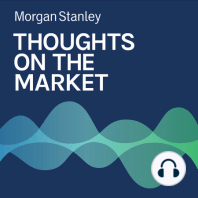3 min listen

Serena Tang: The Return of the 60/40 Portfolio
Serena Tang: The Return of the 60/40 Portfolio
ratings:
Length:
4 minutes
Released:
Nov 16, 2023
Format:
Podcast episode
Description
After poor performance in 2022, a traditional 60/40 equity/bond portfolio could see an annual return around 8% over the next decade.----- Transcript -----Welcome to your Thoughts on the Market. I'm Serena Tang, Morgan Stanley's Chief Cross Asset Strategist. Along with my colleagues, bringing you a variety of perspectives, today, I'll discuss our long run expectations for what markets will return in 2024. It's Thursday, November 16th at 10 a.m. in New York. 2023 has seen a relentless rise in government bond yields. This has hit total multi-asset returns this year, while also lifting nominal expected returns over the long run for fixed income and stocks above historical averages. U.S. equities are expected to return about 9.6% per year for the next decade, little change from the level last year. While ten year U.S. Treasuries are projected to be at 5.8%, up quite significantly from 4.7% in 2022. But the steeper climb in nominal long run expected returns for government bonds is also eroded risk premiums, that is the investment returns assets are expected to yield over and above risk free assets. For example, the equity risk premium for U.S. stocks sits at around 3.8%, down from 4.9% just a year ago. Given soaring yields over the last three months, it's understandable why some investors may be skeptical of fixed income. Except today's higher yields are a strong reason to buy bonds because they can better cushion fixed income returns. In fact, looking across assets, fixed income stands as being particularly cheap to equities relative to history. European and Japanese equities screen cheap to most other assets on an FX-hedged basis, and Euro-denominated assets look cheap to dollar denominated assets. Furthermore, our estimated optimal allocation to agency mortgage backed securities has increased at the expense of investment grade credit over the past year, reflecting how cheap mortgages are relative to other markets. Against this backdrop, a traditional 60/40 portfolio which allocates 60% to stocks and 40% to bonds and carries a moderate level of risk, looks viable once again despite its poor performance in 2022, when both stocks and bonds suffered greatly amid record inflation and aggressive interest rate hikes. From where we sit now, the high long run expected returns across most assets mean that a traditional 60/40 equity bond dollar portfolio would see about 8% per year over the next decade. The last time it was this high was in 2013 and surely a 60/40 equity bond euro portfolio could see 7.7% per year over the next 10 years, the most elevated since 2011.While long-run expected returns have climbed higher, unfortunately for 60/40 strategies correlation has surged. We still think there's some diversification benefits/volatility reduction in a 60/40 portfolio from bonds’ low risk rather than low correlation, but the rise in bond volatility has also challenged this fear. The big question here is whether the high correlation between stocks and bonds will normalize. There's an argument that it won't, and perhaps surprisingly, it's all to do with A.I. Now, for the last three decades or so, the positive relationship between growth and inflation has been an important factor on negative correlation between stocks and bonds. Higher inflation erodes bond returns, and that's offset by higher stock returns from rising growth and vice versa. But in the case of A.I technology diffusions, we can see a boost to growth and reduction in inflation in the short run, which in turn challenges assumptions that stock and bond returns will have low to negative correlations in the future. In other words, bonds, as was the case this year, would no longer be the good diversifier they have been over the last three decades. Timing and sequencing will matter, and how A.I. may impact growth inflation correlations is only one of many factors that can move multi-asset correlation over time. Thanks for listening. If you enjoy the show, please leave us a review on
Released:
Nov 16, 2023
Format:
Podcast episode
Titles in the series (100)
Mike Wilson: How Confident Are U.S. Businesses in the Economy? by Thoughts on the Market